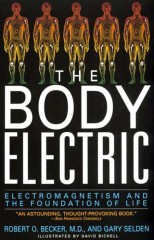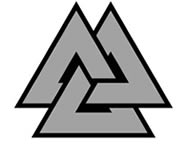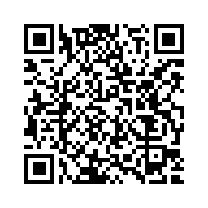
Authors : Becker Robert Otto - Selden Gary
Title : The body electric Electromagnetism and the foundation of life
Year : 1985
Link download : Becker_Robert_Otto_-_The_body_electric.zip
Introduction : The Promise of the Art. I remember how it was before penicillin. I was a medical student at the end of World War II, before the drug became widely available for civilian use, and I watched the wards at New York's Bellevue Hospital fill to overflowing each winter. A veritable Byzantine city unto itself, Bellevue sprawled over four city blocks, its smelly, antiquated buildings jammed together at odd angles and interconnected by a rabbit warren of underground tunnels. In wartime New York, swollen with workers, sailors, soldiers, drunks, refugees, and their diseases from all over the world, it was perhaps the place to get an all-inclusive medical education. Bellevue's charter decreed that, no matter how full it was, every patient who needed hospitalization had to be admitted. As a result, beds were packed together side by side, first in the aisles, then out into the corridor. A ward was closed only when it was physically impossible to get another bed out of the elevator. Most of these patients had lobar (pneumococcal) pneumonia. It didn't take long to develop; the bacteria multiplied unchecked, spilling over from the lungs into the bloodstream, and within three to five days of the first symptom the crisis came. The fever rose to 104 or 105 degrees Fahrenheit and delirium set in. At that point we had two signs to go by: If the skin remained hot and dry, the victim would die; sweating meant the patient would pull through. Although sulfa drugs often were effective against the milder pneumonias, the outcome in severe lobar pneumonia still depended solely on the struggle between the infection and the patient's own resistance. Confident in my new medical knowledge, I was horrified to find that we were powerless to change the course of this infection in any way. It's hard for anyone who hasn't lived through the transition to realize the change that penicillin wrought. A disease with a mortality rate near 50 percent, that killed almost a hundred thousand Americans each year, that struck rich as well as poor and young as well as old, and against which we'd had no defense, could suddenly be cured without fail in a few hours by a pinch of white powder. Most doctors who have graduated since 1950 have never even seen pneumococcal pneumonia in crisis. Although penicillin's impact on medical practice was profound, its impact on the philosophy of medicine was even greater. When Alexander Fleming noticed in 1928 that an accidental infestation of the mold Penicillium notatum had killed his bacterial cultures, he made the crowning discovery of scientific medicine. Bacteriology and sanitation had already vanquished the great plagues. Now penicillin and subsequent antibiotics defeated the last of the invisibly tiny predators. The drugs also completed a change in medicine that had been gathering strength since the nineteenth century. Before that time, medicine had been an art. The masterpiece—a cure—resulted from the patient's will combined with the physician's intuition and skill in using remedies culled from millennia of observant trial and error. In the last two centuries medicine more and more has come to be a science, or more accurately the application of one science, namely biochemistry. Medical techniques have come to be tested as much against current concepts in biochemistry as against their empirical results. Techniques that don't fit such chemical concepts—even if they seem to work—have been abandoned as pseudoscientific or downright fraudulent. At the same time and as part of the same process, life itself came to be defined as a purely chemical phenomenon. Attempts to find a soul, a vital spark, a subtle something that set living matter apart from the nonliving, had failed. As our knowledge of the kaleidoscopic activity within cells grew, life came to be seen as an array of chemical reactions, fantastically complex but no different in kind from the simpler reactions performed in every high school lab. It seemed logical to assume that the ills of our chemical flesh could be cured best by the right chemical antidote, just as penicillin wiped out bacterial invaders without harming human cells. A few years later the decipherment of the DNA code seemed to give such stout evidence of life's chemical basis that the double helix became one of the most hypnotic symbols of our age. It seemed the final proof that we'd evolved through 4 billlion years of chance molecular encounters, aided by no guiding principle but the changeless properties of the atoms themselves. The philosophical result of chemical medicine's success has been belief in the Technological Fix. Drugs became the best or only valid treatments for all ailments. Prevention, nutrition, exercise, lifestyle, the patient's physical and mental uniqueness, environmental pollutants—all were glossed over. Even today, after so many years and millions of dollars spent for negligible results, it's still assumed that the cure for cancer will be a chemical that kills malignant cells without harming healthy ones. As surgeons became more adept at repairing bodily structures or replacing them with artificial parts, the technological faith came to include the idea that a transplanted kidney, a plastic heart valve, or a stainless-steel-and-Teflon hip joint was just as good as the original—or even better, because it wouldn't wear out as fast. The idea of a bionic human was the natural outgrowth of the rapture over penicillin. If a human is merely a chemical machine, then the ultimate human is a robot. No one who's seen the decline of pneumonia and a thousand other infectious diseases, or has seen the eyes of a dying patient who's just been given another decade by a new heart valve, will deny the benefits of technology. But, as most advances do, this one has cost us something irreplaceable: medicine's humanity. There's no room in technological medicine for any presumed sanctity or uniqueness of life. There's no need for the patient's own self-healing force nor any strategy for enhancing it. Treating a life as a chemical automaton means that it makes no difference whether the doctor cares about—or even knows—the patient, or whether the patient likes or trusts the doctor. Because of what medicine left behind, we now find ourselves in a real technological fix. The promise to humanity of a future of golden health and extended life has turned out to be empty. Degenerative diseases— heart attacks, arteriosclerosis, cancer, stroke, arthritis, hypertension, ulcers, and all the rest—have replaced infectious diseases as the major enemies of life and destroyers of its quality. Modern medicine's incredible cost has put it farther than ever out of reach of the poor and now threatens to sink the Western economies themselves. Our cures too often have turned out to be double-edged swords, later producing a secondary disease; then we search desperately for another cure. And the dehumanized treatment of symptoms rather than patients has alienated many of those who can afford to pay. The result has been a sort of medical schizophrenia in which many have forsaken establishment medicine in favor of a holistic, prescient type that too often neglects technology's real advantages but at least stresses the doctor-patient relationship, preventive care, and nature's innate recuperative power. The failure of technological medicine is due, paradoxically, to its success, which at first seemed so overwhelming that it swept away all aspects of medicine as an art. No longer a compassionate healer working at the bedside and using heart and hands as well as mind, the physician has become an impersonal white-gowned ministrant who works in an office or laboratory. Too many physicians no longer learn from their patients, only from their professors. The breakthroughs against infections convinced the profession of its own infallibility and quickly ossified its beliefs into dogma. Life processes that were inexplicable according to current biochemistry have been either ignored or misinterpreted. In effect, scientific medicine abandoned the central rule of science—revision in light of new data. As a result, the constant widening of horizons that has kept physics so vital hasn't occurred in medicine. The mechanistic assumptions behind today's medicine are left over from the turn of the century, when science was forcing dogmatic religion to see the evidence of evolution. (The reeruption of this same conflict today shows that the battle against frozen thinking is never finally won.) Advances in cybernetics, ecological and nutritional chemistry, and solid-state physics haven't been integrated into biology. Some fields, such as parapsychology, have been closed out of mainstream scientific inquiry altogether. Even the genetic technology that now commands such breathless admiration is based on principles unchallenged for decades and unconnected to a broader concept of life. Medical research, which has limited itself almost exclusively to drug therapy, might as well have been wearing blinders for the last thirty years. It's no wonder, then, that medical biology is afflicted with a kind of tunnel vision. We know a great deal about certain processes, such as the genetic code, the function of the nervous system in vision, muscle movement, blood clotting, and respiration on both the somatic and the cellular levels. These complex but superficial processes, however, are only the tools life uses for its survival. Most biochemists and doctors aren't much closer to the "truth" about life than we were three decades ago. As Albert Szent-Gyorgyi, the discoverer of vitamin C, has written, "We know life only by its symptoms." We understand virtually nothing about such basic life functions as pain, sleep, and the control of cell differentiation, growth, and healing. We know little about the way every organism regulates its metabolic activity in cycles attuned to the fluctuations of earth, moon, and sun. We are ignorant about nearly every aspect of consciousness, which may be broadly defined as the self-interested integrity that lets each living thing marshal its responses to eat, thrive, reproduce, and avoid danger by patterns that range from the tropisms of single cells to instinct, choice, memory, learning, individuality, and creativity in more complex life-forms. The problem of when to "pull the plug" shows that we don't even know for sure how to diagnose death. Mechanistic chemistry isn't adequate to understand these enigmas of life, and it now acts as a barrier to studying them. Erwin Chargaff, the biochemist who discovered base pairing in DNA and thus opened the way for understanding gene structure, phrased our dilemma precisely when he wrote of biology, "No other science deals in its very name with a subject that it cannot define." Given the present climate, I've been a lucky man. I haven't been a good, efficient doctor in the modern sense. I've spent far too much time on a few incurable patients whom no one else wanted, trying to find out how our ignorance failed them. I've been able to tack against the prevailing winds of orthodoxy and indulge my passion for experiment. In so doing I've been part of a little-known research effort that has made a new start toward a definition of life. My research began with experiments on regeneration, the ability of some animals, notably the salamander, to grow perfect replacements for parts of the body that have been destroyed. These studies, described in Part 1, led to the discovery of a hitherto unknown aspect of animal life—the existence of electrical currents in parts of the nervous system. This breakthrough in turn led to a better understanding of bone fracture healing, new possibilities for cancer research, and the hope of human regeneration—even of the heart and spinal cord—in the not too distant future, advances that are discussed in Parts 2 and 3. Finally, a knowledge of life's electrical dimension has yielded fundamental insights (considered in Part 4) into pain, healing, growth, consciousness, the nature of life itself, and the dangers of our electromagnetic technology. I believe these discoveries presage a revolution in biology and medicine. One day they may enable the physician to control and stimulate healing at will. I believe this new knowledge will also turn medicine in the direction of greater humility, for we should see that whatever we achieve pales before the self-healing power latent in all organisms. The results set forth in the following pages have convinced me that our understanding of life will always be imperfect. I hope this realization will make medicine no less a science, yet more of an art again. Only then can it deliver its promised freedom from disease. Growth and Regrowth. Salamander : energy's seed sleeping interred in the marrow... Octavio Paz. ...

Demolins Edmond - L'éducation nouvelle
Auteur : Demolins Edmond Ouvrage : L'éducation nouvelle Année : 1898 Lien de téléchargement :...














